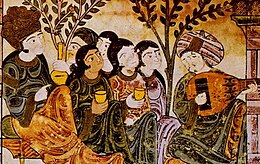Maqsurah
| Part of a series on |
| Arabic culture |
|---|
 |
| Part of a series on |
| Islamic culture |
|---|
| Architecture |
| Art |
| Clothing |
| Holidays |
| Literature |
| Music |
| Theatre |
Maqsurah (Arabic مقصورة) (literally "closed-off space"), an enclosure, a box or wooden screen near the mihrab or the center of the qibla wall, which was originally designed to shield a worshipping ruler from assassins.[1] The imam officiating inside the maqsurah typically belonged to the same school of law to which the ruler belonged.[2]
There also may have been some spiritual connotation similar to the chancel screen in churches. They were often wooden screens decorated with carvings or interlocking turned pieces of wood (similar to a mashrabiya).[3]
Historically, it was first used by the Umayyad caliph Muawiyah I in the Umayyad Mosque of Damascus, where the so-called "Mihrab of the Companions (of the Prophet)" belonged to the "Maqsura of the Companions".[4]
References
- ^ "Maqsurah", Encyclopædia Britannica Online
- ^ Gibbs, H.A.R. The Travels of Ibn Battuta (Munshiram Manoharlal, 1999) p127
- ^ Dictionary of Islamic Architecture Archived 2011-05-25 at the Wayback Machine
- ^ "The Great Ummayad Mosque"
External links
 Media related to Maqsurah at Wikimedia Commons
Media related to Maqsurah at Wikimedia Commons

